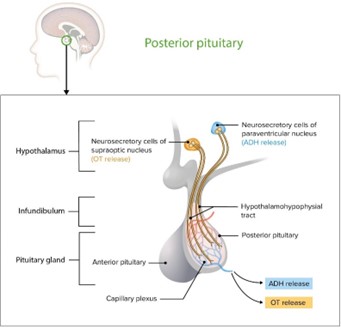Which finding indicates to the nurse that demeclocycline is effective for a patient with a syndrome of inappropriate antidiuretic hormone (SIADH)?
Urine-specific gravity is increased.
Patient's weight is increased.
Peripheral edema is decreased.
Patient’s urinary output is increased.
The Correct Answer is D
Demeclocycline is a tetracycline antibiotic that can be used to treat SIADH, a condition characterized by excessive water retention and a decrease in urinary output. Demeclocycline blocks the action of antidiuretic hormone (ADH), which can help increase urinary output and decrease water retention in patients with SIADH. Therefore, an increase in urinary output would indicate that demeclocycline is effective in treating the patient's SIADH. Options a, b, and c are incorrect because they do not directly relate to the mechanism of action of demeclocycline in treating SIADH.

Nursing Test Bank
Naxlex Comprehensive Predictor Exams
Related Questions
Correct Answer is ["A","C","D"]
Explanation
The correct answers are a, c, and d. The client will need to take thyroid hormone replacement (levothyroxine) for the rest of her life since she had a total thyroidectomy. The dosage will need to be carefully monitored to ensure that it is correct, and laboratory tests will need to be done frequently to monitor thyroid hormone levels. Taking too much of the drug can cause hyperthyroidism symptoms, so it is important not to take more than prescribed. It is also important to check with a healthcare provider before taking any other medications or herbs, as they can interact with levothyroxine.
Answer b is incorrect because the client will need to take the drug for the rest of her life.

Correct Answer is A
Explanation
The nurse should anticipate that the patient will need to collect a stool specimen. Diarrhea can be caused by various factors such as infections, inflammatory bowel disease, food intolerance, and medication side effects. Collecting a stool specimen can help identify the underlying cause of the diarrhea and guide appropriate treatment. Blood cultures, colonoscopy but barium enema may be necessary in certain cases but are not typically the first step in the diagnostic process for diarrhea.
Whether you are a student looking to ace your exams or a practicing nurse seeking to enhance your expertise , our nursing education contents will empower you with the confidence and competence to make a difference in the lives of patients and become a respected leader in the healthcare field.
Visit Naxlex, invest in your future and unlock endless possibilities with our unparalleled nursing education contents today
Report Wrong Answer on the Current Question
Do you disagree with the answer? If yes, what is your expected answer? Explain.
Kindly be descriptive with the issue you are facing.
